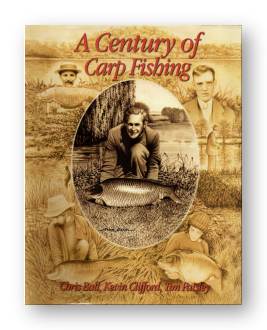Reviewed by Barrie Rickards
**Real Reviews by Real Anglers**
As well as being quite astonishing value for money, this a beautifully produced book. Even some of the old black and white photographs are so well set up, with a whisper of shading beneath the print (giving a 3D effect) that they give a real pleasure. There is such a wealth of good stuff it’s difficult to know where to begin. What I will say is that the book really does cover the last century of carp angling: it has all the old stuff, and a great deal that is smack up to date. Apart from carp it discusses people, and their roles, past and present, and it does this without a hint of personality culting. The whole book is an absolute mine of information and a joy to read. 
Everyone will have their favourite chapters, of course, and mine must include Kevin Clifford’s ‘Pre – 50’s – The Dawn of Change’ and ‘The Fifties – Walker’s Revolution’. I was fishing then and can remember some of the events fairly well, as well as knowing a number of anglers involved, Walker included. In the second of these chapters I think Kevin Clifford very fairly appraises Richard Walker’s vital role in transforming carp fishing. Looking back at the writings of the time, and Walker’s in particular, I don’t think anyone would now argue that what was written in terms of technique was what transformed carping. Many of those techniques were fundamentally flawed, as subsequent experience shows. But I think Walker inspired what was to follow. You could always see Walker at two ends: firstly his column in Angling Times, other articles, and his books; secondly on a close-up, personal front which we see well in the recently published letters of the Carp Catchers Club. In the first he inspires, and this is what affected most freshwater anglers in the country. In the second he dominates. As Kevin Clifford points out, the CCC was doomed once Walker began to lose interest in carp and to consider ‘…..that there is far less to discuss about carp than there used to be’ (4th August 1960). Where he dominated, on a personal level, I think ideas were curtailed or suppressed: we see this in the letters of the CCC time and time again, so that particle baits, hooks, leads and rod-design were all subjects where other members raised questions but seemed to let them fade in deference to Walker. Many great people have this conflict in their make-up: the ability to inspire and the ability to pour cold water. Again, as Kevin Clifford says, paraphrasing Shakespeare, ‘when you stand on the shoulders of a giant you can see for along way.’
Chris Ball got lumbered with a rather difficult chapter to write, ‘The Sixties – Things Start to Swing’. The 60’s lacked the real mystery and romance of the 50’s, and also the headiness of the end of the century. Nevertheless, very important things were happening, not the least being the changeover from split cane to glass-fibre rods. With view of hindsight I don’t think, myself, that Richard Walker’s MK IV cane rod was man enough for the job: this explains why it failed to set hooks so that fish came adrift very easily, as well as the number of fish lost in snags and weed. The new glass rods slowly became more powerful. Chris mentions the Sportex blanks (Tag Barnes rods), Davenport and Fordham rods, and Olivers of Knebworth. I still have a pair of the first two, and three Olivers rods. I still have my pair of MK IV’s (made from JB Walker blanks), and their softness is soon obvious compared with the glass rods. The 60’s were also the time when bivvies arrived, called Brolly Camps as a rule. What a change these were from the home-made throw-over or wrap-around efforts. I still have my original one, use it occasionally, and it works perfectly: it is made of black PVC and it is heavy. 1963 also saw the last big freeze-up which for me in Yorkshire ended with only two days left in the season. Many, many big carp died, and some people thought for a while that the fabulous Redmire fish had gone. And the 60’s had their crop of big names, truly great anglers – Jack Hilton, Bill Quinlan, Bob Reynolds, Gerry Savage, Jim Gibbinson, and so on.
Following Chris Ball’s chapter is a series on the 70’s, 80’s and 90’s with Tim Paisley in association with others. These deal not only with fish and people, but also with the great discoveries, especially Fred Wilton’s boilies and the Middleton/Maddock’s hair rig which, together with particle baits, really did revolutionise carp angling in a way that none of the CCC predicted. I won’t go on chapter by chapter, except to say that there are chapters in France, Europe, and the world. The world’s biggest carp (plural); carp tackle; rigs; baits; waters; publications; organisations and the personalities.
It is almost impossible to convey, even in a longish review such as this, just how much information is contained in this book. It is a mammoth achievement by any standards you care to name. I have never been much of a carp fisher, but you would have to a strange bod not to love this book. And if you think about other books, such as Redmire Pool, A History of Carp Fishing, and the CCC letters plus this volume, you have a literary achievement that is probably unmatched anywhere in angling – sea, game, big game or coarse. I am very, very glad that these books, and these events, happened in my time.
TITLE: A Century of Carp Fishing
AUTHORS: Chris Ball, Kevin Clifford & Tim Paisley
PUBLISHERS: Carptalk Enterprises
PRICE: £ 25
PAGES: 336 (with an average of three photographs per page).













